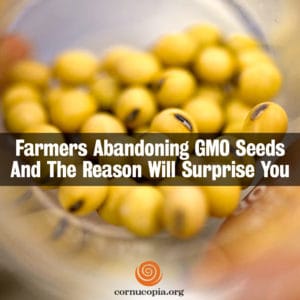Off the Grid News
by Daniel Jennings
 A growing number of farmers are abandoning genetically modified seeds, but it’s not because they are ideologically opposed to the industry.
A growing number of farmers are abandoning genetically modified seeds, but it’s not because they are ideologically opposed to the industry.
Simply put, they say non-GMO crops are more productive and profitable.
Modern Farmer magazine discovered that there is a movement among farmers abandoning genetically modified organisms (GMO) because of simple economics.
“We get the same or better yields, and we save money up front,” crop consultant and farmer Aaron Bloom said of non-GMO seeds. Bloom has been experimenting with non-GMO seeds for five years and he has discovered that non-GMO is more profitable.
The re-converts to non-GMO seeds are not hippies but conservative Midwestern farmers who are making a business decision, Modern Farmer discovered. They are switching back to natural seed because it is more profitable — not because of any ideology.
“Five years ago the [GMO seeds] worked,” said farmer Christ Huegerich, who along with his father planted GMO seeds. “I didn’t have corn rootworm because of the Bt gene, and I used less pesticide. Now, the worms are adjusting, and the weeds are resistant. Mother Nature adapts.”
Farmers can get paid more for conventional corn than GMO corn. Plus, Huegerich discovered, convention corn can produce more per acre. Modern Farmer reported that two years ago, Huegerich planted 320 acres of conventional corn and 1,700 with GMO corn. The conventional fields “yielded 15 to 30 more bushels per acre than the GMO fields, with a profit margin of up to $100 more per acre.” Last year, he planted convention corn in 750 acres.
“I get a fifty-cent-per-bushel premium,” Huegerich said of the non-GMO corn he grows in Breda, Iowa.
Herbicide use increased by 26 percent between 2001 and 2010 because of the spread of herbicide-resistant weeds. Huegerich said he used herbicides on GMO corn and conventional corn, even though theoretically he shouldn’t have to use it on his genetically modified crop.
The group Farm & Water Watch reported that 61.2 million acres of cropland in the US are plagued by weeds that are resistant to the popular glyphosate herbicides.
Why Non-GMO Seeds Are More Profitable
The Modern Farmer article, called The Post GMO-Economy, makes an excellent case for farmers dumping GMO. Some of the interesting facts the magazine uncovered include:
- The cost of growing one acre of non-GMO corn was $680.95, the cost of growing an acre of GMO corn was $761.80 according to Aaron Bloom. That means it costs $80.85 more an acre to raise GMO corn.
- GMO seeds can cost up to $150 a bag more than regular seeds.
- The market for non-GMO foods has grown from $1.3 billion in 2011 to $3.1 billion in 2013, partially because some Asian and European countries don’t want GMO seeds.
- Grain dealer Clarkson Grain pays farmers an extra $2 a bushel for non-GMO soybeans and an additional $1 a bushel for non-GMO corn.
- The market for non-GMO seed is growing. Sales at Spectrum Seed Solutions, which sells non-GMO seed, have doubled every year for the last four years. Sales at another company that markets non-GMO seeds, eMerge Genetics of West Des Moines, Iowa, have increased by 30 percent a year for five years.
- Spectrum Seed Solutions president Scott Odle thinks that non-GMO corn could be 20 percent of the market in five years.
Bloom, the farm consultant, said planting convention corn can save farmers an average of $81 per acre per season. That’s a difference of $81,000 for a farm of 1,000 acres.
It looks like the past might be the future for farmers as more and more growers abandon GMO. The free market could very well spell the end of GMO seeds.

